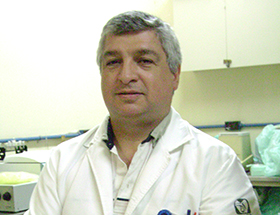
Trichomonad total extracts (TTE), or vesicular (P30) and soluble (530) subcellular fractions from 3 pathogenic Trichomonas vaginalis strains (GT-3. GT-13. and GT-15), lysed both human and Sprague-Dawley rat erythrocytes in a time- and dose-dependent manner. The entire hemolytic activity of TTE was located in P30, showing 2 peaks of maximum activity, one at pH 6.0 and another at pH 8.0. in the presence of 1 mM Ca2+. Hemolytic activity on rat erythrocytes was greater at pH 6.0 16.71 +/- 0.33 hemolytic units IHU]/mg/hr to 11.60 +/- 0.24 HU/mg/hr) than at pH 8.0 (3.81 +/- 0.30 HU/mg/hr to 5.75 +/- 0.65 HU/mg/hr). and it was greater than that on human red blood cells at pH 6.0 (2.67 +/- 0.19 HU/mg/hr to 4.08 +/- 0.15 HU/mg/hr) or pH 8.0 (2.24 +/- 0.0 9 HU/mg/hr to 2.81 +/- 0.06 HU/mg/hr). The alkaline and acidic hemolytic activity diminished (60-93% at pH 6.0 and 78-93% at pH 8.0) by the effect of 80 microM Rosenthal's inhibitor, which also inhibited 27-45% and 29-54% trichomonad alkaline and acidic phospholipase A activities, respectively. Vesicles, vacuoles, and hydrogenosomes were rich in P30. Trichomonas vaginalis has a hemolytic PLA, which could be involved in its cytopathogenic mechanism.





.png)



